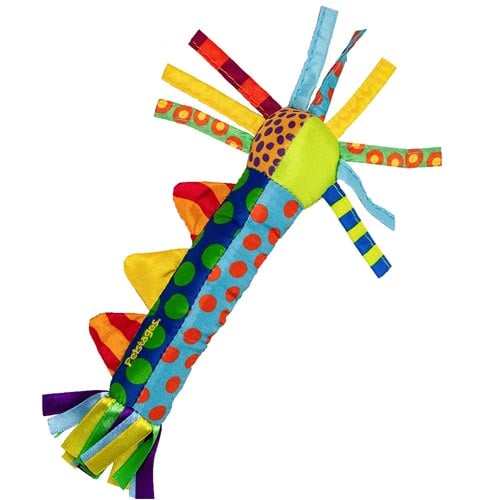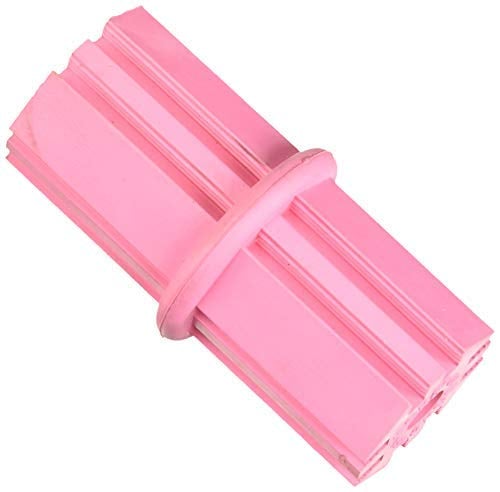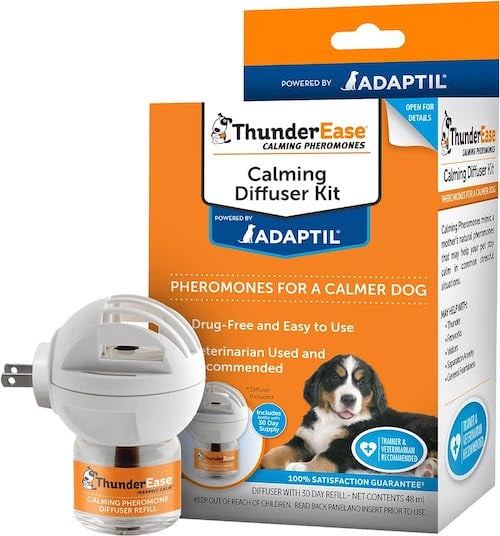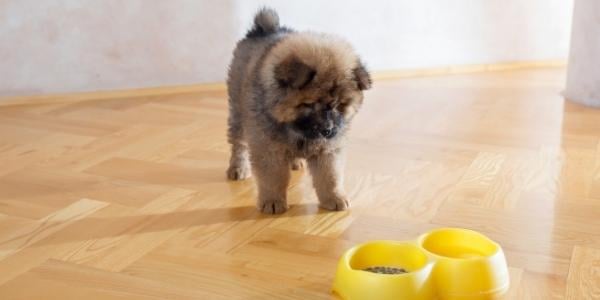
PUPPIES!! They are a great joy, the best evidence of unconditional love, and one of the greatest stresses there is.
Puppies provide us with so much that when they aren’t quite themselves, we get pretty stressed out.
We know how important it is for growing puppies to eat, and when they don’t want to eat, we get more worried.
Skip to Section:
Reasons why puppies stop eating
Besides the long-term risks of puppies not eating as they should, there are some immediate risks to take into account when your puppy refuses to eat. Puppies, unlike older dogs, don’t have fat reserves.
Therefore, they can’t go longer than 12 hours without food. This is particularly true for toy breeds that are prone to hypoglycemia (a drop in blood sugar), which can lead to serious complications.
Puppies are also more susceptible to dehydration than older dogs.
This seems especially the case if their main diet is canned food, as pups eating the "wetter" canned food tend to drink less.
Reasons Why Puppies Stop Eating
Your puppy’s loss of appetite or anorexia may be sudden, or they may gradually eat less over a period of time. There are several things that may contribute to your puppy’s loss of appetite. Here is a list of the more common reasons.
Finicky Eater
Being a picky eater isn't all that common in puppies. After all, your puppy has two qualities that should make them happy to eat just about anything: they're (1) a dog and (2) a puppy! However, in some cases, puppies can become picky eaters and have certain preferences in their eating habits.
To be on the safe side, you always want to have your puppy's veterinarian evaluate them to be sure they are healthy if they show signs of not wanting to eat.
If your puppy is given a clean bill of health by their veterinarian, consider whether they are happy to eat other things besides their meals, such as healthy dog treats or dog-safe fruit.
If they are happily eating those things, it may be that they are getting a bit picky with their regular food. You have a couple of options here:
- Change their food. You certainly wouldn't want to be forced to eat something you don't like, day after day. Sometimes it's as easy as switching to a different texture or hardness of food. I don't advise changing the protein source (chicken, beef, etc.) unless your dog has been diagnosed with a food allergy.
Changing protein sources for your dog can make it more challenging in the future should your pup develop food sensitivities or allergies. This is one reason why, when pets do develop food allergies, they have to be fed veterinary hypoallergenic diets (which tend to be much more expensive) instead of limited ingredient or new protein diets. Stick with the same protein even if you're switching or adding canned food to their meals. And be sure to change your puppy's food gradually to avoid stomach upset. - Make their food more enticing. This may be a food topper, fish oil supplement (although, don't overdo it, and remember that it is a fish protein in case of allergy concerns), or some wet food. Even just wetting the food with warm water and letting it sit for a few minutes can make it more enticing (read: smelly) for your puppy. Do this before you offer the food to your puppy.
You don't want to build a habit of them refusing dry food and learning that doing so means you'll add something yummy. (They're always learning!) The goal here is to just get calories in. See below for some options on food toppers to try.
If a puppy is truly being picky — again, this is rare — the usual recommendations from canine behavior consultants are to put the food down for 15 to 30 minutes and then put it away if uneaten after that time. It doesn't reappear again until their next mealtime.
HOWEVER, because it's extremely important for a puppy to get enough calories from a balanced diet, this isn't recommended for young puppies or toy breeds that are prone to hypoglycemia (low blood sugar).
Be sure to rule out other causes for their lack of appetite first, and then speak with your veterinarian about whether they are old enough to try this method.
Stress and Anxiety
Just like it can for humans, stress can suppress your puppy’s desire to eat. Maybe you brought them home very recently. If you have children, maybe they have just gone back to school, and the puppy is experiencing separation anxiety. Or maybe the kids are spending more time at home. Maybe you’ve got a full house for the holidays, which can stress out anyone! Or maybe your pup is being “bullied” by other pets in your home — don’t underestimate the cat!
Although puppies don’t have bills to pay or life-draining jobs to rush off to, it’s important to recognize that they can still experience stress.
All puppies (and adult dogs) can go through a bit of an "adjustment period” when they first come home, having just left a familiar environment (and possibly their mother or siblings) for an unfamiliar one filled with strangers. Keep an eye open for potential sources of stress for your pup.
High Temperatures
Most people don’t have a desire to eat when it is hot. Well, the same can hold true for puppies. When the temperature outside is up, your pup’s appetite may be down. If you think this might be the reason, check out some ways to help keep your pup cool.
Teething or Pain
Just like babies become fussy about eating when they are teething, so can puppies. The discomfort and soreness they experience in their mouth can make them reluctant to eat their food, especially if it is dry food.
The pain could be from an injury — after all, puppies can be quite accident-prone! Pups can also experience inflammation of their pancreas (pancreatitis) or growing pains from their developing bones. They could even have something stuck in their mouth — like a splinter or piece of wood from chewing on a stick — or a broken tooth from a bad chew toy.
Check for any external or obvious sources of pain. If you don’t see any, it might be time for a quick check-up at the vet. See below for some teething toy suggestions and alternatives to dry food.

Digestive Upset or Obstruction
Puppies are notorious for eating things they shouldn’t, and unfortunately, many puppy owners intentionally give their dogs snacks and “treats” that they shouldn’t.
Some snacks and treats, whether stolen by your puppy or given freely by you, can cause digestive upset as well as obesity and begging later in life. They may even cause your puppy to reject the healthier and balanced dog foods they should be eating!
You can greatly decrease the chance of your pup sneaking their own treats by puppy-proofing your home and teaching them not to counter surf. And even if neither of you is doing anything “naughty,” some puppy foods can just be too rich for some dogs, and every puppy will handle certain foods differently.
If your pup is having diarrhea for more than 12 hours, they are at risk for dehydration. The risk for dehydration increases if your puppy is also vomiting.
It is time to seek medical attention if:
- Diarrhea continues past 12 hours – sooner if your puppy is also vomiting
- There is blood in their diarrhea or vomit
- Your puppy’s gums are whitish or gray
- Your puppy is lethargic or weak
- Your puppy is obviously dehydrated – dry and tacky gums
Note: To determine dehydration, you can do a skin tent test. Simply lift the skin and fur at the nape of your dog’s neck. If the skin and fur don’t go back immediately, your puppy is likely dehydrated. For those that are severely dehydrated, the skin will remain tented. This is a critical situation for puppies, and medical attention is needed immediately.
For $5, you can connect with a veterinarian to discuss your puppy's eating issue and get help for your dog's specific situation. Connect now
Rates may differ for those residing outside the U.S. You'll have access to a vet for 7 days.
Digestive Infections
Unfortunately, there are plenty of viruses (Parvo), intestinal worms (like roundworms), bacteria, and other “creepy crawlies” that can set up shop in your puppy’s gut and cause a range of problems. Many puppies have roundworms or other parasites in their gut before you get them home. This is a big part of the reason why we vets usually deworm puppies at their puppy visits, recommend fecal (poop) testing, and vaccinate to prevent Parvo and other devastating diseases.
Organ Disease or Dysfunction
Puppies can suffer from problems in their liver, kidneys, endocrine/hormonal system, and pretty much any other organ or part of their body. It can be the result of problems they were born with (like a liver shunt), an infection, toxic injury, or something else they’ve picked up.
For example, puppies with liver shunts will have stunted growth, poor muscle development, abnormal behavior such as head pressing, seizures, circling, etc. They may also have vomiting, diarrhea, or abnormal appetites.
Acute kidney failure due to a toxin or infection can cause decreased appetite, abnormal urination, vomiting, nausea, diarrhea, etc.
Respiratory Infection
One of the more common respiratory infections, kennel cough, can be mild and self-resolving, but it can also spread and reach the lungs. Additionally, some puppies can get so congested that they can’t smell. For some, this can be another reason not to want to eat.
The best way to protect your puppy from kennel cough (and perhaps even canine influenza, a.k.a. “dog flu”) is to talk to your vet about vaccinating against these diseases and keeping your pup away from the dog parks or doggy daycare until they’re protected and ready, which is usually at least 17 weeks old!

What to Do When Your Puppy Isn’t Eating
Remember, puppies don’t have the same fat reserves as adult dogs. Therefore, missing a meal or two can be problematic and be a cause for concern.
Always err on the side of caution and call your veterinarian for advice in these situations.
Below are some things you can do to try and tempt your puppy’s appetite at home.
Tips to Increase a Puppy’s Appetite
If Feeding Dry Food:
- Add some warm water and let it sit for a few minutes. Add about 1 part water to 3 parts dry food. You can even warm it in the microwave for 30 to 60 seconds to enhance the smell. Be sure it is not too hot before giving it to your puppy.
- Add in a little bit of canned food. Some puppies like it cold, some room temperature, and some prefer it warmed. Basically, you will need to experiment a little to determine your puppy’s preference.
Note: Choosing canned food is best done with your veterinarian's recommendation, but you can start by looking to see if the dry food you feed your pup is available in canned form. And stick with the same protein source. If the kibble is chicken, find a canned chicken food.
Some choices if you're going to add a canned wet food suddenly are: Purina EN or Royal Canin Puppy GI. However, these diets and the options below all require a veterinary prescription. Veterinary-formulated diets are meant to treat, cure, or alleviate certain medical conditions, and if they are used incorrectly or for the wrong condition, they could cause other health issues. These diets should always be used under veterinary supervision.
When you need a truly smelly and appetite-stimulating canned food, Royal Canin's Recovery canned food is a good option. - If you wanted to switch dry foods – normally you'd want to transition over time – but because it's critical for a puppy to eat, this food is safer to switch suddenly. Purina Pro Plan Veterinary Diets EN Gastroenteric dry canine formula provides complete and balanced nutrition for the growth of puppies and maintenance of adult dogs, including the growth of large breed dogs (70 lbs or more as an adult).
- You can try adding some peanut butter. Just be sure that it doesn’t contain xylitol.
If Feeding Canned Food:
- Try offering it cold, room temperature, or warm to find your pup's preference.
Safe Dog Food Toppers for Both Dry and Canned Foods:
- Try adding a little bit of warmed, low-sodium chicken broth to your pup’s food. (Avoid broths containing onions, onion powder, chives, or garlic — as these can cause a breakdown of your pup's red blood cells.) Mix Native Pet's Bone Broth powder with water as a pet-safe way to add broth to their food, or sprinkle this broth-flavored food topper on their food.
- Some pups will perk up their appetite when you add a little bit of plain boiled white rice or pasta to their meals, or some boiled and shredded, boneless, skinless, spice-less chicken breast.
- Add some low-sodium green beans can encourage some puppies to eat. And the added benefit of green beans is that they contain essential vitamins and minerals, as well as fiber.
- Add a little bit of plain cottage cheese or plain yogurt (just make sure the yogurt doesn’t contain xylitol, an increasingly common sugar substitute that is safe for people but extremely dangerous for dogs).
- Add some room temperature or warmed chicken or turkey baby food (the brands we linked to don't contain onions, which shouldn't be in any food you give your dog).
- Add some fruit, such as blueberries, cantaloupe, cranberries, etc. DO NOT give grapes, raisins, or currants since they are toxic. Check out our list of safe (and unsafe) fruits you can give your dog.
- You can also try a very small amount of canned pumpkin. While pumpkin has a lot of benefits, sometimes too much of a good thing can create issues. For example, excess fiber from the pumpkin could block the absorption of protein if the puppy consumes more of it than their normal diet. Additionally, too much can cause diarrhea, which would be an additional complication.
Change Up How You Feed Your Puppy:
- Put their food in an interactive toy (a.k.a. “puzzle feeder”) to make mealtimes more stimulating and fun.
- If you normally feed your pup their food in a bowl, try a different type (stainless steel instead of plastic) or switch to a plate.
- Change where you feed your puppy. There may be something in the area that makes them feel like it isn’t safe to eat or they get easily distracted. Feeding them in their crate or puppy playpen is the best idea, which provides some separation from other dogs, cats, and the hustle and bustle of your home. It also has the added bonus of creating a positive association with their crate (an essential part of crate training) and helping prevent resource guarding issues.
- You may need to stimulate their appetite by increasing activity before mealtime. Try taking them for a walk or have playtime before you plan to feed them.
- Leaving food out all the time may mean your puppy is eating all the time (even if you don’t see them) and therefore are not hungry at mealtimes. Try setting a fixed feeding schedule to see if they will eat once hungry.
If Your Puppy Is Teething:
Teething can be incredibly uncomfortable and painful for your puppy. Providing puppy-safe teething toys can give them some relief. A cooling teething stick can help soothe gum irritation and feel good to gnaw on, and the softer rubber in puppy teething toys is gentler on your puppy's sore mouth.
Help Your Puppy's Stress:
If you suspect your puppy is experiencing any type of stress, you can try plugging in an Adaptil diffuser – natural calming pheromone – to help calm your pup. These pheromones mimic the scent of a mother nursing her puppies, encouraging a sense of safety and security.
Provide calming enrichment activities. Licking, chewing, and sniffing are excellent for not only providing mental enrichment but also for self-soothing. Spread some wet food on a licking mat (you can even freeze it to make it longer-lasting or to use on hot days) and give it to your puppy in their crate or playpen to work on.
Make sure to supervise their licking mat session, as these aren't meant as chew toys. You can even blend up their dry food with some water or food topper and then smear it on the licking mat so they can get those much-needed food calories.
You can try spreading a bit of your dog's wet food, peanut butter, pureed pumpkin, or low-fat Greek yogurt on this mat to provide a soothing enrichment activity.
If you feel really desperate, you can attempt hand feeding. Just be warned, this could become a habit your puppy starts to rely on! Start by feeding from your hand and then work towards holding the bowl for them instead of feeding straight from your hand. From there, you can build them up to eating from the bowl on the floor while you're further away
Don't Over Treat:
Be sure that you are not giving too many treats and spoiling meal time. A puppy that is full of yummy treats won't eat their regular meals because they just aren't hungry. There are a couple of options here to help mitigate extra treat calories and to ensure your puppy is getting a complete and balanced diet during intensive training.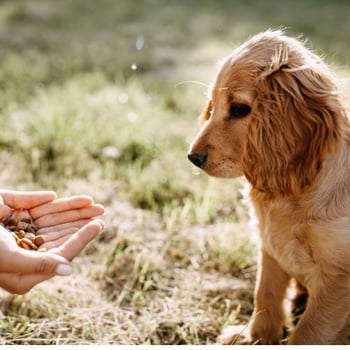
- Use a portion of your dog's regular food as their training treats. Measure out their daily allotment and pull out a portion to use for training exercises.
PRO TIP: Regular food often isn't high-value enough for puppy training in high-distraction areas. Use regular food treats indoors and for easy cues, saving the high-value training treats for puppy class or practice out and about. - Rely on a different type of food as a training treat. For example, if your puppy eats dry food for meals, use air-dried dog food for treats, such as the Ziwi Peak Air-Dried food. The texture is different, and many dogs find these types of food more valuable than dry food, but they are still formulated to provide a balanced diet.
- Speak with your veterinarian about how many calories your puppy should be consuming each day. This will help you balance out the calories they are getting from treats with the amount they are getting from food.
- Incorporate real-life rewards for your puppy's training. One of the best things you can do when training your puppy is to practice identifying what it is that they want in a particular moment and then using that as a reinforcer and reward for their behavior. It's not always about treats! For instance, they might want your attention, access to the yard, to go for a walk, or to play. By using these real-life rewards from the start with your puppy, only using treats to get better focus or to teach a brand new behavior, you'll be on the right track for fading out food treats later on in life.
Signs That It’s Time to Take Your Puppy to the Vet
Don’t hold out for too long. If the above methods don’t work, or your puppy is displaying the following symptoms, you should bring them in for veterinary evaluation.- If your puppy has missed one of their daily meals and then isn’t showing interest in their next meal.
- If your puppy is vomiting and/or having diarrhea.
- If your puppy has decreased energy.
- If your puppy is weak.
- If your puppy shows signs of hypoglycemia (low blood sugar) – abnormal gait (walking), weakness, seizures, and even coma.
- If multiple dogs in your home or among your circle of friends are also experiencing decreased appetite.
- If you know your pup has recently gotten into the trash (or dirty laundry).
- If your puppy got into cleaning agents (mop water, freshly cleaned toilet, etc.).
- If any toys are recently missing or destroyed.
- If you hear from your puppy’s breeder that other dogs in the litter are ill.
- If they've recently been spending time at the dog park, doggy daycare, or any other group of dogs.
- If your puppy was just vaccinated.
- If the whites of their eyes, their gums, or the inside of their ears are yellow (or even yellowish). See the photo below as an example of a dog's eye that is yellow.
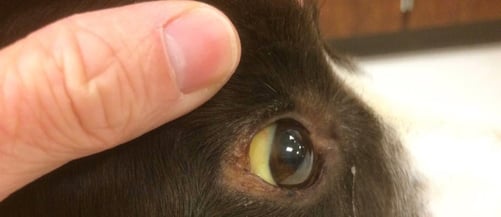
Questions? To chat with a veterinarian about why your puppy might not be eating, Click here
Why It's Critical For Your Puppy to Eat Properly
For a growing puppy, a good, well-balanced diet is extremely important. Puppies have unique nutritional requirements and therefore need diets specially formulated for their optimal health and growth.
When they are not fed appropriately, there is a risk that the puppy’s long-term health could be compromised. You are laying the foundation of a healthy adult when you properly feed your puppy.
A well-balanced puppy diet will help:
- Achieve a healthy growth rate – not too rapid and not too slow. This is extra important for large and giant breed puppies.
- Support proper immune functions
- Prevent the possible occurrence of developing orthopedic issues in the legs and hips
When you are looking for the right diet, you want to purchase food with the AAFCO (American Association of Feed Control Officials) certification. This is the organization that supervises the entire pet food industry.
An ideal diet will also have completed a feeding trial before it is marketed. You want to feed a diet formulated for puppies based on their size (small breed versus large breed formulations are different). A good puppy diet should contain the proper levels of DHA. DHA is an omega-3 fatty acid that is critical in the development of the puppy’s brain and eyes.




